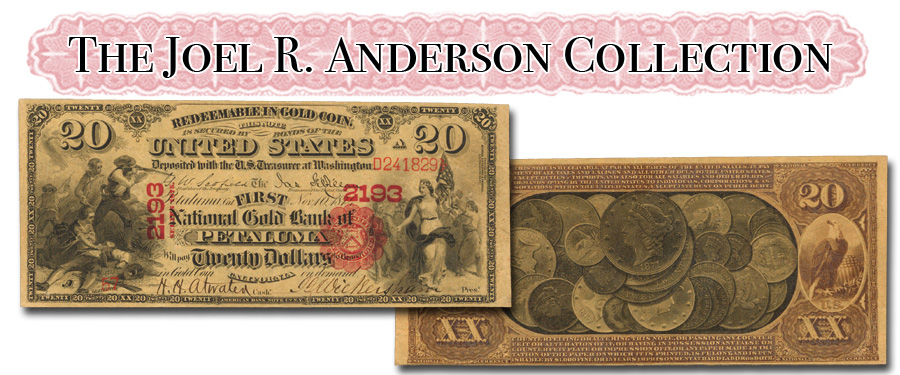
Among
the various series of federal currency from 1861 to date, one of the rarest
classes is National Gold Bank Notes. Introduced in 1870, these were made for
circulation in California. That state had a peculiar clause in its 1850
Constitution that forbid the use of paper money at par in circulation. While in
the East and Midwest hundreds of state-chartered banks issued currency from
that time until 1866, and while National Bank Notes were issued by many banks
beginning in 1864, in California it was only “hard money” that circulated at
par. During the Gold Rush days the coins included private and
Congress-authorized issues of various denominations from $1 to $50, the last
including many of octagonal shape. When federal notes were brought into the
state, such as to pay military and government personnel, the bills traded at a
deep discount. This caused many problems, as might be expected.
The
solution was the issuance of National Gold Bank Notes that were redeemable at
face value in federal gold coins. These circulated effectively. Of a special
design and on tinted paper, they were issued by vary various National Banks in
California, mostly by the National Gold Bank of San Francisco. As related
below, only about 60 notes in total from all banks combined are known.
Notes
issued in Petaluma are all landmark rarities today. The Joel R. Anderson
Collection includes the finer (by a long distance) of only two $20 notes in
existence today. The term once in a lifetime
opportunity would seem to be appropriate here, as it is for many other
notes from the Joel R. Anderson Collection.
Our
catalog description:
Lot
2069.
Incredible
$20 Petaluma National Gold Bank Note Rarity
The
Finest Example of the Type
Petaluma,
California. $20 1875. Friedberg 1157 (Whitman-2062). The First National Gold
Bank. Charter #2193. PCGS Currency Extremely Fine 45.
Offered
is one of the greatest National Gold Bank Notes we have ever had the honor of
presenting at auction. This 1875 $20 from the National Gold Bank of Petaluma is
the finest example of the type graded by either PCGS or PMG. Furthermore, it is
one of the finest known examples from the entire series of National Gold Bank
Notes.
The
face design is very similar to that of Original and Series of 1875 $20 National
Bank notes with the Battle of Lexington, 1775 vignette
at left and Loyalty at right. The
back displays an assortment of period U.S. gold coinage at center including an
1871 double eagle.
While
most National Gold Bank Notes show extensive wear, this note is an exception,
as just faint traces of circulation are observed. The darkly printed design is
perfectly framed with full margins. The overprints on the face are bold red and
the bank officers’ signatures are both neatly penned in sharp inks.
Roughly
60 $20 National Gold Bank Notes are known from all banks combined. Of those
approximately half come from the National Gold Bank of San Francisco. The
present note is one of just two $20s known from the National Gold Bank of
Petaluma. The other is graded Very Good and realized $43,475 in an April 2017
auction. The presently offered note is far superior and was last sold at
auction for $230,000 in June 2007. The market for great rarities is much stronger
now and we expect the price for this note to reach well into the six-figure
range.
About
the Bank
The
First National Gold Bank of Petaluma was chartered on October 12, 1874, with an
authorized capital of $200,000. I.G. Wickersham was the founding president and
H.H. Adwater was the first cashier. It transitioned to become the First
National Bank of Petaluma on April 17, 1884. It was placed in voluntary
liquidation on September 25, 1894, with the capital of $200,000. It was
succeeded by the Wickersham Banking Company, which operated under a state
charter.
PCGS
Population: 1; none
finer.
From B.
Max Mehl 1953; Ex. Amon Carter; Lyn Knight’s sale of February 2003, lot 2126;
Lyn Knight’s sale of June 2007, lot 95.





